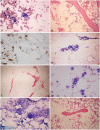Bone Marrow Suppression and Hemophagocytic Histiocytes Are Common Findings in Korean Severe Fever with Thrombocytopenia Syndrome Patients
- PMID: 27401664
- PMCID: PMC4960399
- DOI: 10.3349/ymj.2016.57.5.1286
Bone Marrow Suppression and Hemophagocytic Histiocytes Are Common Findings in Korean Severe Fever with Thrombocytopenia Syndrome Patients
Abstract
The causes of cytopenia in patients with severe fever with thrombocytopenia syndrome (SFTS) are not fully understood until now. We reviewed the bone marrow (BM) findings of patients with SFTS to unravel the cause of the cytopenia. Three Korean SFTS were enrolled in this study. Thrombocytopenia, neutropenia, and anemia were detected in all three patients. Severe hypocellular marrow (overall cellularity <5%) and a decreased number of megakaryocytes were noted in one patient, and hypo-/normocellular marrow and an increased number of hemophagocytic histiocytes were observed in two patients. Megakaryocytes were relatively preserved in two patients. Although a limited number of cases are available, our observations suggest that both BM suppression and peripheral destruction or sequestration are causes of cytopenia of patients with SFTS. To the best of our knowledge, this is the first well documented pathologic evaluation of Korean SFTS.
Keywords: Korea; Severe fever with thrombocytopenia syndrome bunyavirus; bone marrow.
Conflict of interest statement
The authors have no financial conflicts of interest.
Figures

Similar articles
-
A patient with severe fever with thrombocytopenia syndrome and hemophagocytic lymphohistiocytosis-associated involvement of the central nervous system.J Infect Chemother. 2018 Apr;24(4):292-297. doi: 10.1016/j.jiac.2017.10.016. Epub 2017 Nov 11. J Infect Chemother. 2018. PMID: 29138019
-
Bone marrow findings in severe fever with thrombocytopenia syndrome: prominent haemophagocytosis and its implication in haemophagocytic lymphohistiocytosis.J Clin Pathol. 2016 Jun;69(6):537-41. doi: 10.1136/jclinpath-2015-203417. Epub 2015 Nov 16. J Clin Pathol. 2016. PMID: 26908283
-
A study of cytological changes in the bone marrow of patients with severe fever with thrombocytopenia syndrome.PLoS One. 2013 Dec 12;8(12):e83020. doi: 10.1371/journal.pone.0083020. eCollection 2013. PLoS One. 2013. PMID: 24349423 Free PMC article. Clinical Trial.
-
Missing Cells: Pathophysiology, Diagnosis, and Management of (Pan)Cytopenia in Childhood.Front Pediatr. 2015 Jul 13;3:64. doi: 10.3389/fped.2015.00064. eCollection 2015. Front Pediatr. 2015. PMID: 26217651 Free PMC article. Review.
-
[Severe fever with thrombocytopenia syndrome].Nihon Rinsho. 2016 Dec;74(12):1985-1991. Nihon Rinsho. 2016. PMID: 30550654 Review. Japanese.
Cited by
-
Application of the severe fever with thrombocytopenia syndrome prediction score: Differentiation of febrile diseases using basic laboratory parameters.PLoS One. 2020 Mar 5;15(3):e0229920. doi: 10.1371/journal.pone.0229920. eCollection 2020. PLoS One. 2020. PMID: 32134948 Free PMC article.
-
Higher Fatality for Severe Fever with Thrombocytopenia Syndrome Complicated by Hemophagocytic Lymphohistiocytosis.Yonsei Med J. 2019 Jun;60(6):592-596. doi: 10.3349/ymj.2019.60.6.592. Yonsei Med J. 2019. PMID: 31124344 Free PMC article.
-
Clinical significance of C-reactive protein in patients with severe fever with thrombocytopenia syndrome.J Rural Med. 2025 Apr;20(2):66-70. doi: 10.2185/jrm.2024-059. Epub 2025 Apr 1. J Rural Med. 2025. PMID: 40182159 Free PMC article.
-
Long-term clinical sequelae in severe fever with thrombocytopenia syndrome: A longitudinal cohort study.PLoS Negl Trop Dis. 2025 Aug 12;19(8):e0013276. doi: 10.1371/journal.pntd.0013276. eCollection 2025 Aug. PLoS Negl Trop Dis. 2025. PMID: 40794812 Free PMC article.
-
Systems Biology-Based Platforms to Accelerate Research of Emerging Infectious Diseases.Yonsei Med J. 2018 Mar;59(2):176-186. doi: 10.3349/ymj.2018.59.2.176. Yonsei Med J. 2018. PMID: 29436184 Free PMC article. Review.
References
-
- Kim WY, Choi W, Park SW, Wang EB, Lee WJ, Jee Y, et al. Nosocomial transmission of severe fever with thrombocytopenia syndrome in Korea. Clin Infect Dis. 2015;60:1681–1683. - PubMed
Publication types
MeSH terms
LinkOut - more resources
Full Text Sources
Other Literature Sources
Medical

